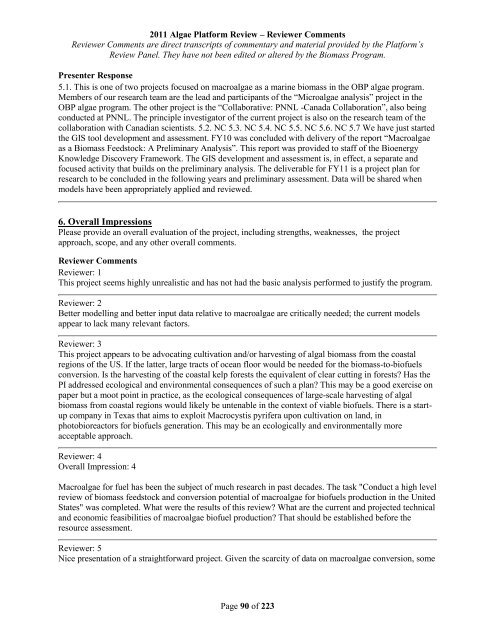Reviewer Comments - EERE
Reviewer Comments - EERE
Reviewer Comments - EERE
Create successful ePaper yourself
Turn your PDF publications into a flip-book with our unique Google optimized e-Paper software.
2011 Algae Platform Review – <strong>Reviewer</strong> <strong>Comments</strong><br />
<strong>Reviewer</strong> <strong>Comments</strong> are direct transcripts of commentary and material provided by the Platform’s<br />
Review Panel. They have not been edited or altered by the Biomass Program.<br />
Presenter Response<br />
5.1. This is one of two projects focused on macroalgae as a marine biomass in the OBP algae program.<br />
Members of our research team are the lead and participants of the “Microalgae analysis” project in the<br />
OBP algae program. The other project is the “Collaborative: PNNL -Canada Collaboration”, also being<br />
conducted at PNNL. The principle investigator of the current project is also on the research team of the<br />
collaboration with Canadian scientists. 5.2. NC 5.3. NC 5.4. NC 5.5. NC 5.6. NC 5.7 We have just started<br />
the GIS tool development and assessment. FY10 was concluded with delivery of the report “Macroalgae<br />
as a Biomass Feedstock: A Preliminary Analysis”. This report was provided to staff of the Bioenergy<br />
Knowledge Discovery Framework. The GIS development and assessment is, in effect, a separate and<br />
focused activity that builds on the preliminary analysis. The deliverable for FY11 is a project plan for<br />
research to be concluded in the following years and preliminary assessment. Data will be shared when<br />
models have been appropriately applied and reviewed.<br />
6. Overall Impressions<br />
Please provide an overall evaluation of the project, including strengths, weaknesses, the project<br />
approach, scope, and any other overall comments.<br />
<strong>Reviewer</strong> <strong>Comments</strong><br />
<strong>Reviewer</strong>: 1<br />
This project seems highly unrealistic and has not had the basic analysis performed to justify the program.<br />
<strong>Reviewer</strong>: 2<br />
Better modelling and better input data relative to macroalgae are critically needed; the current models<br />
appear to lack many relevant factors.<br />
<strong>Reviewer</strong>: 3<br />
This project appears to be advocating cultivation and/or harvesting of algal biomass from the coastal<br />
regions of the US. If the latter, large tracts of ocean floor would be needed for the biomass-to-biofuels<br />
conversion. Is the harvesting of the coastal kelp forests the equivalent of clear cutting in forests? Has the<br />
PI addressed ecological and environmental consequences of such a plan? This may be a good exercise on<br />
paper but a moot point in practice, as the ecological consequences of large-scale harvesting of algal<br />
biomass from coastal regions would likely be untenable in the context of viable biofuels. There is a startup<br />
company in Texas that aims to exploit Macrocystis pyrifera upon cultivation on land, in<br />
photobioreactors for biofuels generation. This may be an ecologically and environmentally more<br />
acceptable approach.<br />
<strong>Reviewer</strong>: 4<br />
Overall Impression: 4<br />
Macroalgae for fuel has been the subject of much research in past decades. The task "Conduct a high level<br />
review of biomass feedstock and conversion potential of macroalgae for biofuels production in the United<br />
States" was completed. What were the results of this review? What are the current and projected technical<br />
and economic feasibilities of macroalgae biofuel production? That should be established before the<br />
resource assessment.<br />
<strong>Reviewer</strong>: 5<br />
Nice presentation of a straightforward project. Given the scarcity of data on macroalgae conversion, some<br />
Page 90 of 223




